window FIAT MULTIPLA 2006 1.G User Guide
[x] Cancel search | Manufacturer: FIAT, Model Year: 2006, Model line: MULTIPLA, Model: FIAT MULTIPLA 2006 1.GPages: 266, PDF Size: 4.61 MB
Page 59 of 266
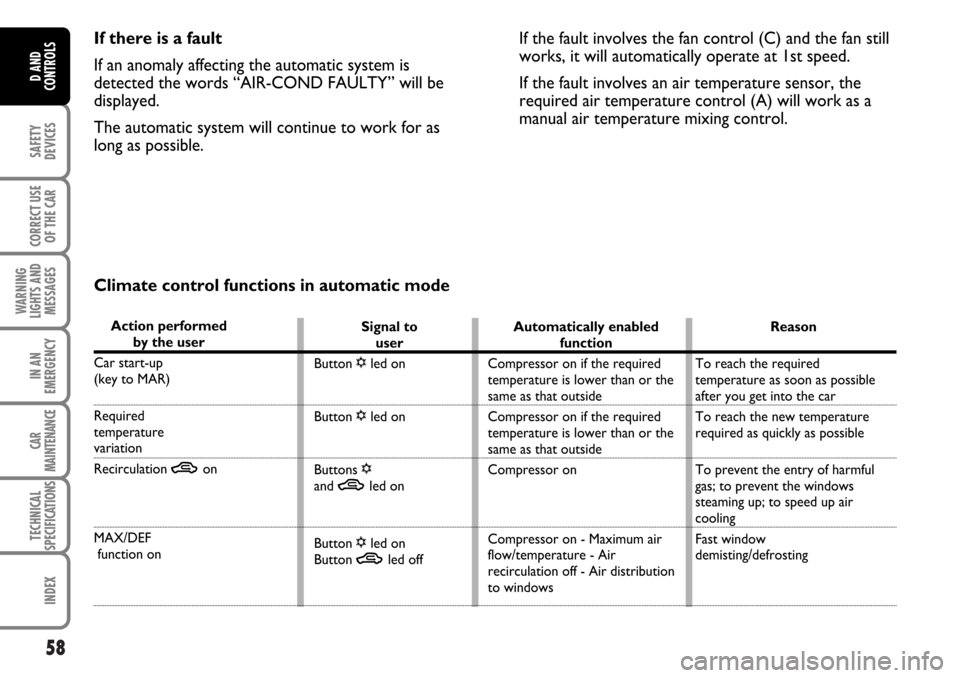
58
SAFETY
DEVICES
CORRECT USE
OF THE CAR
WARNING
LIGHTS AND
MESSAGES
IN AN
EMERGENCY
CAR
MAINTENANCE
TECHNICAL
SPECIFICATIONS
INDEX
D AND
CONTROLS
If there is a fault
If an anomaly affecting the automatic system is
detected the words “AIR-COND FAULTY” will be
displayed.
The automatic system will continue to work for as
long as possible.If the fault involves the fan control (C) and the fan still
works, it will automatically operate at 1st speed.
If the fault involves an air temperature sensor, the
required air temperature control (A) will work as a
manual air temperature mixing control.
Climate control functions in automatic mode
Reason
To reach the required
temperature as soon as possible
after you get into the car
To reach the new temperature
required as quickly as possible
To prevent the entry of harmful
gas; to prevent the windows
steaming up; to speed up air
cooling
Fast window
demisting/defrosting Automatically enabled
function
Compressor on if the required
temperature is lower than or the
same as that outside
Compressor on if the required
temperature is lower than or the
same as that outside
Compressor on
Compressor on - Maximum air
flow/temperature - Air
recirculation off - Air distribution
to windows Signal to
user
Button √led on
Button √led on
Buttons √
and Tled on
Button √led on
Button Tled off Action performedby the user
Car start-up
(key to MAR)
Required
temperature
variation
Recirculation Ton
MAX/DEF
function on
Page 62 of 266
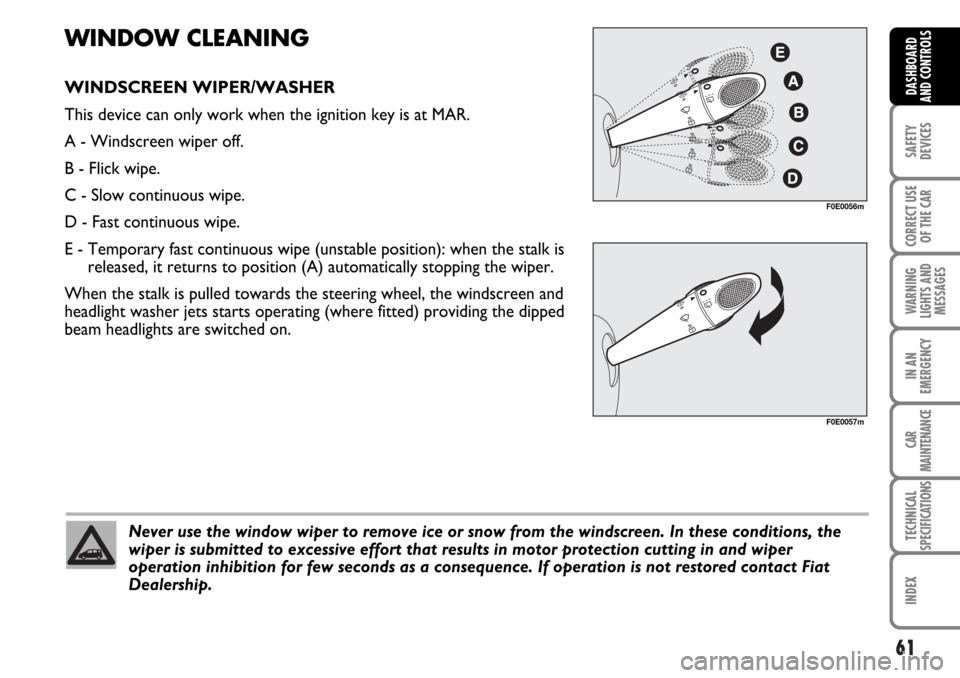
61
SAFETY
DEVICES
CORRECT USE
OF THE CAR
WARNING
LIGHTS AND
MESSAGES
IN AN
EMERGENCY
CAR
MAINTENANCE
TECHNICAL
SPECIFICATIONS
INDEX
DASHBOARD
AND CONTROLS
Never use the window wiper to remove ice or snow from the windscreen. In these conditions, the
wiper is submitted to excessive effort that results in motor protection cutting in and wiper
operation inhibition for few seconds as a consequence. If operation is not restored contact Fiat
Dealership.
WINDOW CLEANING
WINDSCREEN WIPER/WASHER
This device can only work when the ignition key is at MAR.
A - Windscreen wiper off.
B - Flick wipe.
C - Slow continuous wipe.
D - Fast continuous wipe.
E - Temporary fast continuous wipe (unstable position): when the stalk is
released, it returns to position (A) automatically stopping the wiper.
When the stalk is pulled towards the steering wheel, the windscreen and
headlight washer jets starts operating (where fitted) providing the dipped
beam headlights are switched on.
F0E0056m
F0E0057m
Page 63 of 266
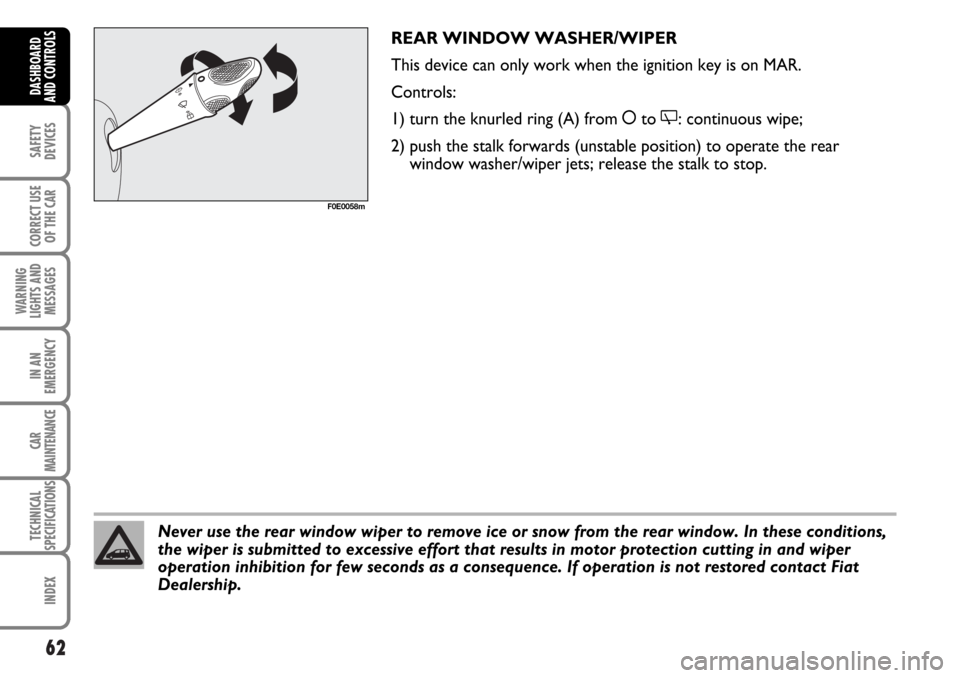
62
SAFETY
DEVICES
CORRECT USE
OF THE CAR
WARNING
LIGHTS AND
MESSAGES
IN AN
EMERGENCY
CAR
MAINTENANCE
TECHNICAL
SPECIFICATIONS
INDEX
DASHBOARD
AND CONTROLS
Never use the rear window wiper to remove ice or snow from the rear window. In these conditions,
the wiper is submitted to excessive effort that results in motor protection cutting in and wiper
operation inhibition for few seconds as a consequence. If operation is not restored contact Fiat
Dealership.REAR WINDOW WASHER/WIPER
This device can only work when the ignition key is on MAR.
Controls:
1) turn the knurled ring (A) from åto': continuous wipe;
2) push the stalk forwards (unstable position) to operate the rear
window washer/wiper jets; release the stalk to stop.
F0E0058m
Page 66 of 266
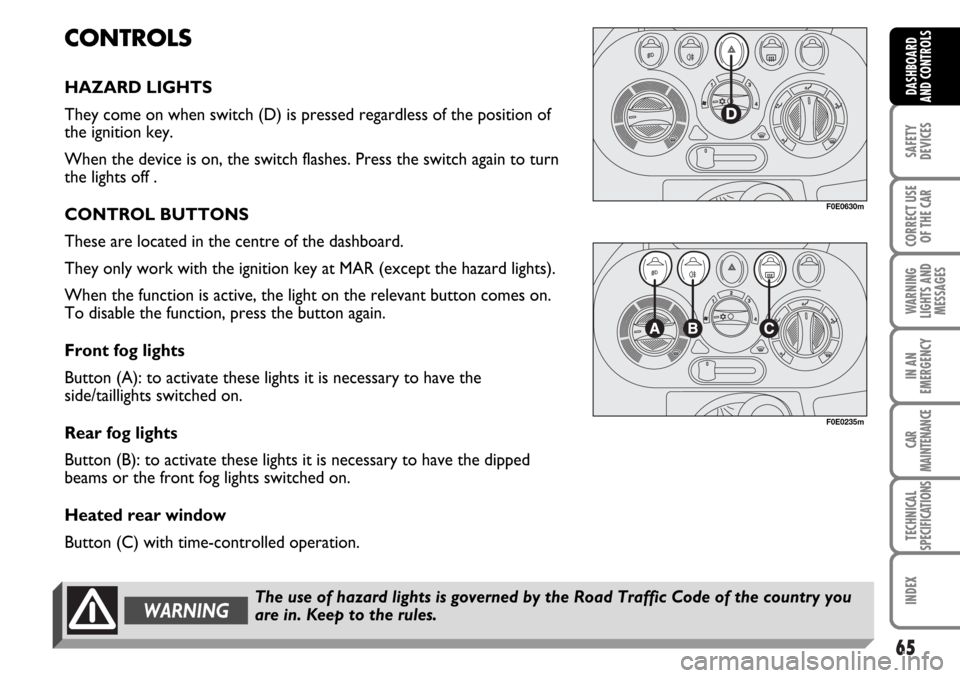
65
SAFETY
DEVICES
CORRECT USE
OF THE CAR
WARNING
LIGHTS AND
MESSAGES
IN AN
EMERGENCY
CAR
MAINTENANCE
TECHNICAL
SPECIFICATIONS
INDEX
DASHBOARD
AND CONTROLS
CONTROLS
HAZARD LIGHTS
They come on when switch (D) is pressed regardless of the position of
the ignition key.
When the device is on, the switch flashes. Press the switch again to turn
the lights off .
CONTROL BUTTONS
These are located in the centre of the dashboard.
They only work with the ignition key at MAR (except the hazard lights).
When the function is active, the light on the relevant button comes on.
To disable the function, press the button again.
Front fog lights
Button (A): to activate these lights it is necessary to have the
side/taillights switched on.
Rear fog lights
Button (B): to activate these lights it is necessary to have the dipped
beams or the front fog lights switched on.
Heated rear window
Button (C) with time-controlled operation.
F0E0630m
F0E0235m
The use of hazard lights is governed by the Road Traffic Code of the country you
are in. Keep to the rules.WARNING
Page 77 of 266
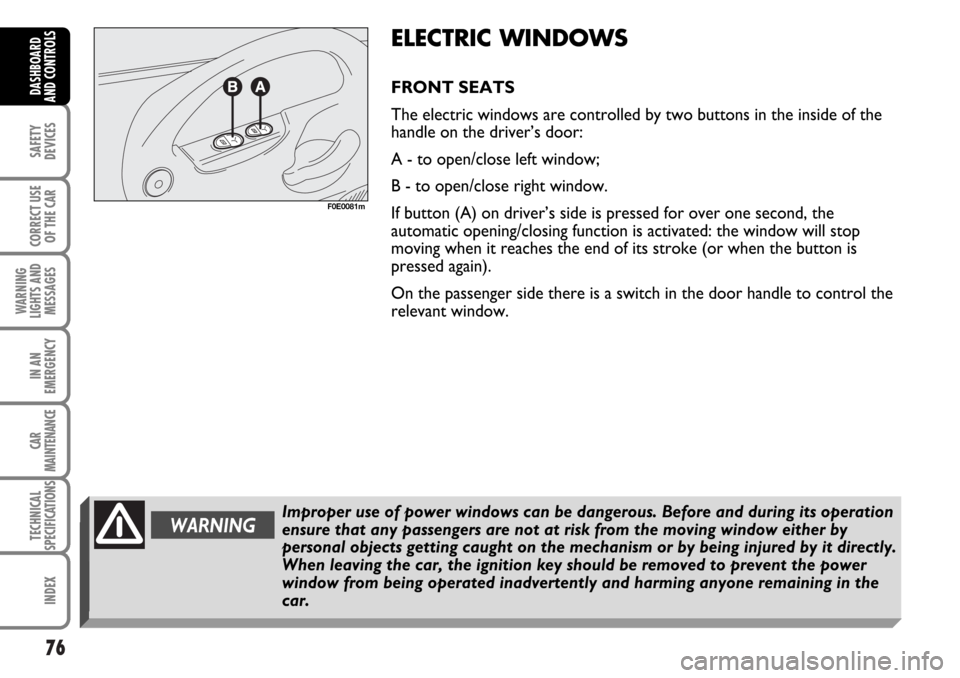
76
SAFETY
DEVICES
CORRECT USE
OF THE CAR
WARNING
LIGHTS AND
MESSAGES
IN AN
EMERGENCY
CAR
MAINTENANCE
TECHNICAL
SPECIFICATIONS
INDEX
DASHBOARD
AND CONTROLS
WARNINGImproper use of power windows can be dangerous. Before and during its operation
ensure that any passengers are not at risk from the moving window either by
personal objects getting caught on the mechanism or by being injured by it directly.
When leaving the car, the ignition key should be removed to prevent the power
window from being operated inadvertently and harming anyone remaining in the
car.
F0E0081m
ELECTRIC WINDOWS
FRONT SEATS
The electric windows are controlled by two buttons in the inside of the
handle on the driver’s door:
A - to open/close left window;
B - to open/close right window.
If button (A) on driver’s side is pressed for over one second, the
automatic opening/closing function is activated: the window will stop
moving when it reaches the end of its stroke (or when the button is
pressed again).
On the passenger side there is a switch in the door handle to control the
relevant window.
Page 78 of 266
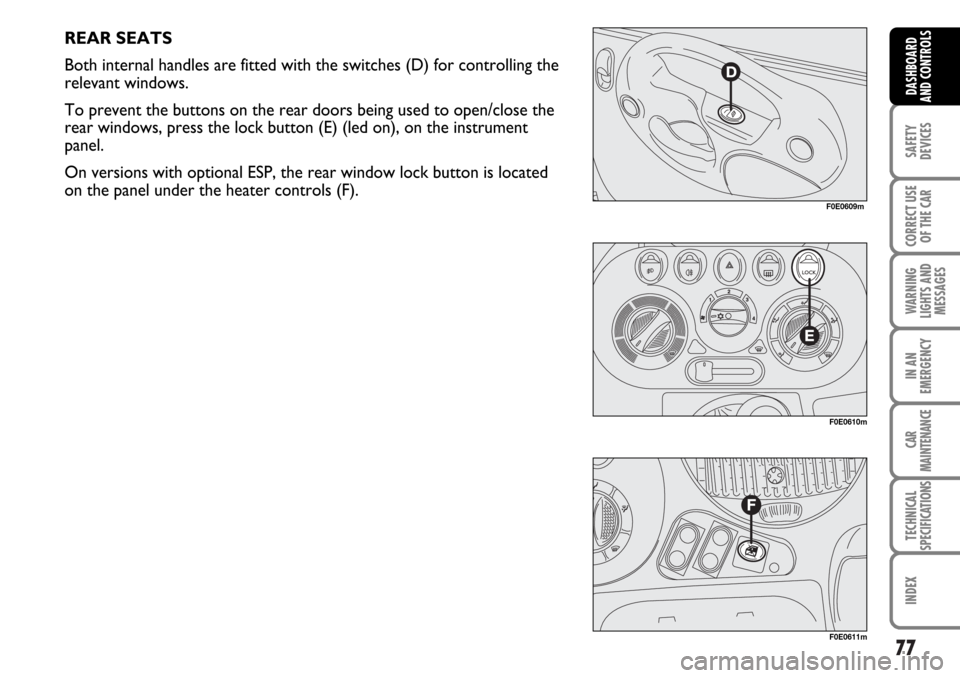
77
SAFETY
DEVICES
CORRECT USE
OF THE CAR
WARNING
LIGHTS AND
MESSAGES
IN AN
EMERGENCY
CAR
MAINTENANCE
TECHNICAL
SPECIFICATIONS
INDEX
DASHBOARD
AND CONTROLS
REAR SEATS
Both internal handles are fitted with the switches (D) for controlling the
relevant windows.
To prevent the buttons on the rear doors being used to open/close the
rear windows, press the lock button (E) (led on), on the instrument
panel.
On versions with optional ESP, the rear window lock button is located
on the panel under the heater controls (F).
F0E0610m
F0E0611m
F0E0609m
Page 82 of 266
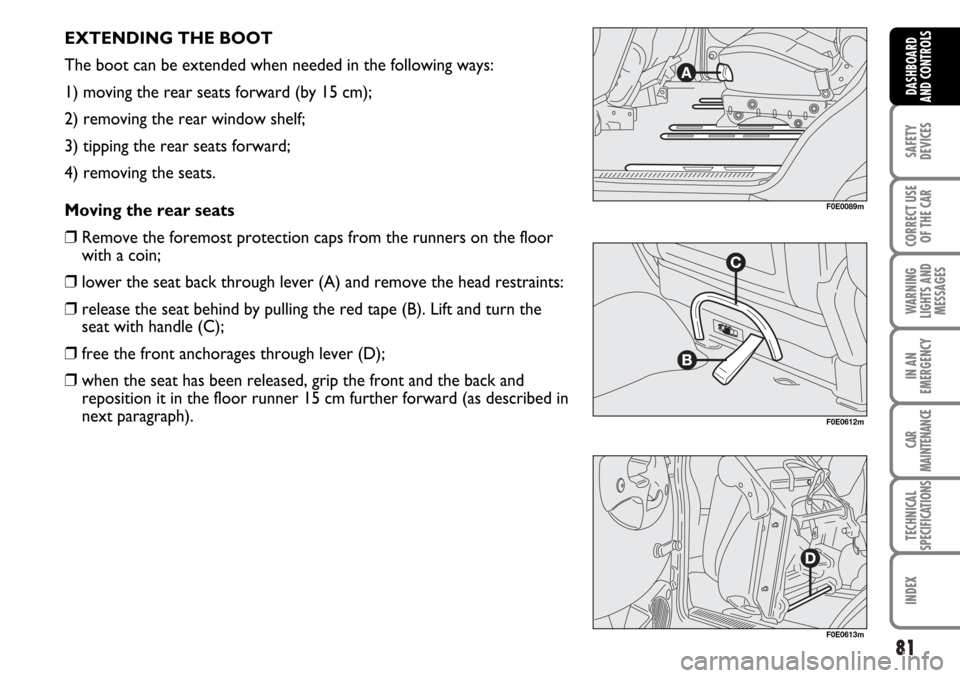
81
SAFETY
DEVICES
CORRECT USE
OF THE CAR
WARNING
LIGHTS AND
MESSAGES
IN AN
EMERGENCY
CAR
MAINTENANCE
TECHNICAL
SPECIFICATIONS
INDEX
DASHBOARD
AND CONTROLS
EXTENDING THE BOOT
The boot can be extended when needed in the following ways:
1) moving the rear seats forward (by 15 cm);
2) removing the rear window shelf;
3) tipping the rear seats forward;
4) removing the seats.
Moving the rear seats
❒Remove the foremost protection caps from the runners on the floor
with a coin;
❒lower the seat back through lever (A) and remove the head restraints:
❒release the seat behind by pulling the red tape (B). Lift and turn the
seat with handle (C);
❒free the front anchorages through lever (D);
❒when the seat has been released, grip the front and the back and
reposition it in the floor runner 15 cm further forward (as described in
next paragraph).
F0E0089m
F0E0612m
F0E0613m
Page 84 of 266
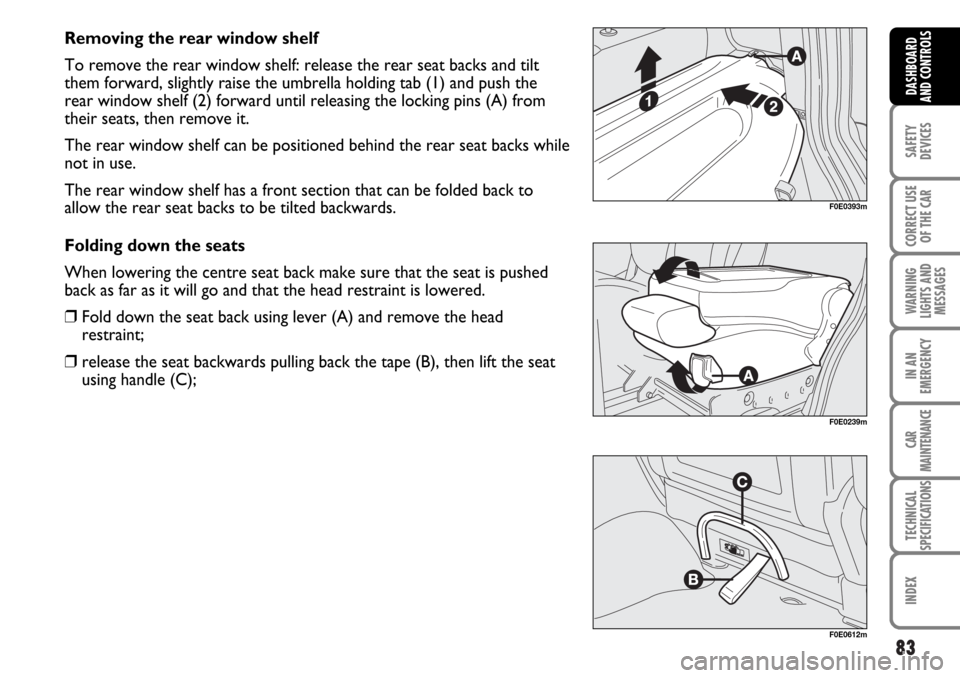
83
SAFETY
DEVICES
CORRECT USE
OF THE CAR
WARNING
LIGHTS AND
MESSAGES
IN AN
EMERGENCY
CAR
MAINTENANCE
TECHNICAL
SPECIFICATIONS
INDEX
DASHBOARD
AND CONTROLS
Removing the rear window shelf
To remove the rear window shelf: release the rear seat backs and tilt
them forward, slightly raise the umbrella holding tab (1) and push the
rear window shelf (2) forward until releasing the locking pins (A) from
their seats, then remove it.
The rear window shelf can be positioned behind the rear seat backs while
not in use.
The rear window shelf has a front section that can be folded back to
allow the rear seat backs to be tilted backwards.
Folding down the seats
When lowering the centre seat back make sure that the seat is pushed
back as far as it will go and that the head restraint is lowered.
❒Fold down the seat back using lever (A) and remove the head
restraint;
❒release the seat backwards pulling back the tape (B), then lift the seat
using handle (C);
F0E0239m
F0E0393m
F0E0612m
Page 112 of 266
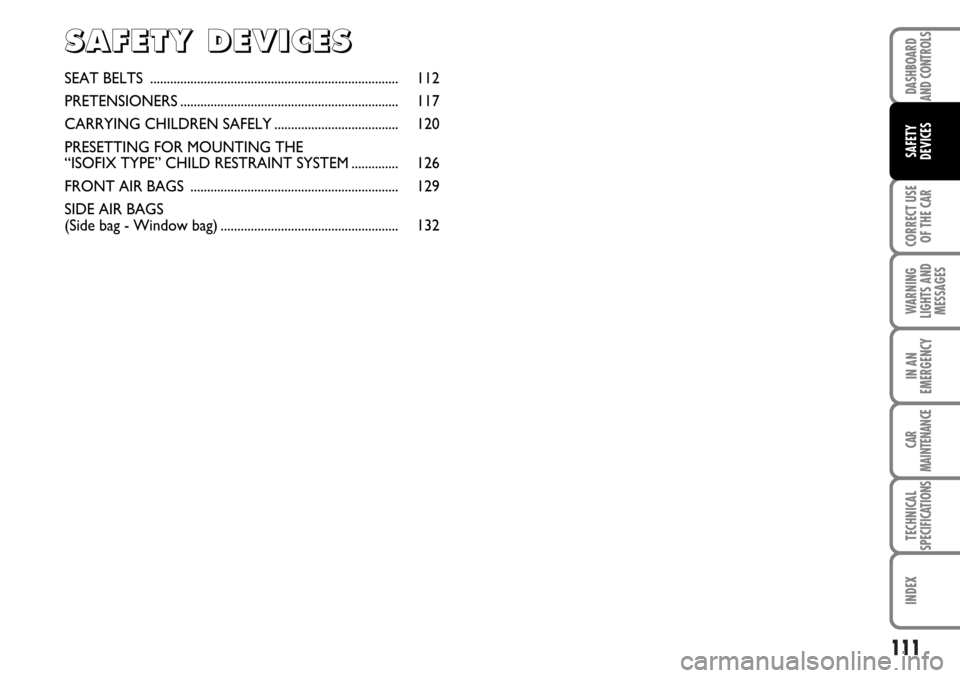
111
CORRECT USE
OF THE CAR
WARNING
LIGHTS AND
MESSAGES
IN AN
EMERGENCY
CAR
MAINTENANCE
TECHNICAL
SPECIFICATIONS
INDEX
DASHBOARD
AND CONTROLS
SAFETY
DEVICES
S S
A A
F F
E E
T T
Y Y
D D
E E
V V
I I
C C
E E
S S
SEAT BELTS .......................................................................... 112
PRETENSIONERS ................................................................. 117
CARRYING CHILDREN SAFELY ..................................... 120
PRESETTING FOR MOUNTING THE
“ISOFIX TYPE” CHILD RESTRAINT SYSTEM .............. 126
FRONT AIR BAGS .............................................................. 129
SIDE AIR BAGS
(Side bag - Window bag) ..................................................... 132
Page 130 of 266
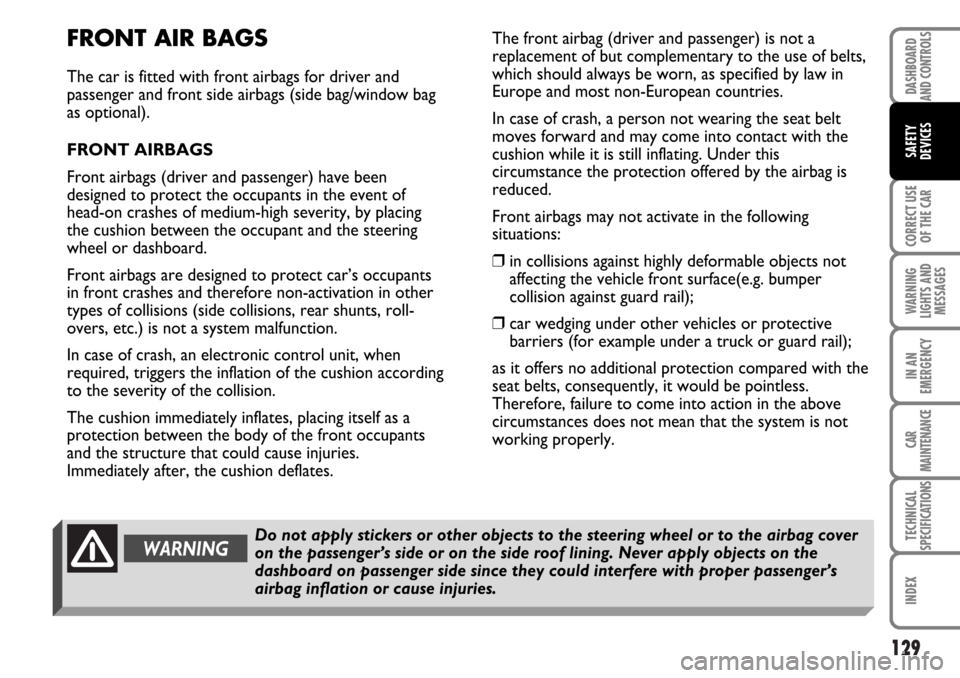
129
CORRECT USE
OF THE CAR
WARNING
LIGHTS AND
MESSAGES
IN AN
EMERGENCY
CAR
MAINTENANCE
TECHNICAL
SPECIFICATIONS
INDEX
DASHBOARD
AND CONTROLS
SAFETY
DEVICES
FRONT AIR BAGS
The car is fitted with front airbags for driver and
passenger and front side airbags (side bag/window bag
as optional).
FRONT AIRBAGS
Front airbags (driver and passenger) have been
designed to protect the occupants in the event of
head-on crashes of medium-high severity, by placing
the cushion between the occupant and the steering
wheel or dashboard.
Front airbags are designed to protect car’s occupants
in front crashes and therefore non-activation in other
types of collisions (side collisions, rear shunts, roll-
overs, etc.) is not a system malfunction.
In case of crash, an electronic control unit, when
required, triggers the inflation of the cushion according
to the severity of the collision.
The cushion immediately inflates, placing itself as a
protection between the body of the front occupants
and the structure that could cause injuries.
Immediately after, the cushion deflates.The front airbag (driver and passenger) is not a
replacement of but complementary to the use of belts,
which should always be worn, as specified by law in
Europe and most non-European countries.
In case of crash, a person not wearing the seat belt
moves forward and may come into contact with the
cushion while it is still inflating. Under this
circumstance the protection offered by the airbag is
reduced.
Front airbags may not activate in the following
situations:
❒in collisions against highly deformable objects not
affecting the vehicle front surface(e.g. bumper
collision against guard rail);
❒car wedging under other vehicles or protective
barriers (for example under a truck or guard rail);
as it offers no additional protection compared with the
seat belts, consequently, it would be pointless.
Therefore, failure to come into action in the above
circumstances does not mean that the system is not
working properly.
WARNINGDo not apply stickers or other objects to the steering wheel or to the airbag cover
on the passenger’s side or on the side roof lining. Never apply objects on the
dashboard on passenger side since they could interfere with proper passenger’s
airbag inflation or cause injuries.